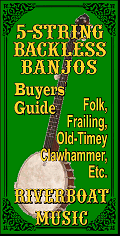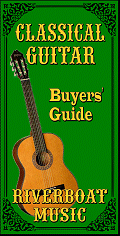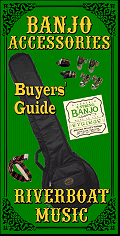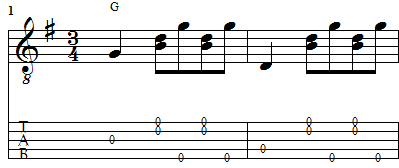Acoustic Instrument
Primers
What Kind of Guitar
Should I Start On?
What Kind of Banjo
Do I Want?
Evaluating and
Buying Used
Guitars
Setting Up
Fretted Instruments Whatever Happened
to the Banjo?
Beginning Five-
String Banjo
6-String Banjos
Banjo Pickups
Axes in my Life
What is a
Bluegrass Banjo?
Dean "Backwoods
Six" Shootout
Music Theory
Primers
Introduction
to Scales
Introduction
to Chords
Circle of Fifths
Other Articles
About Music
How to Give
Guitar Lessons
Musician or
Wannabe? Did God Really
Give Rock &
Roll to You?
Are You a
"Brand Bigot"?
Who Owns Folk Songs?
Historical Links
About the
National Road
The Story Behind
the Story - Real
People, Places,
and Events
About the Play
Play Home
What's New
Overview
About the
Music
About the
History
About the
Logistics
About the
Cast
Synopsis
About the
Set
About the
Author
Contact Us
Home



|

|



Beginning Five-String Folk Banjo - Part Seven - 3/4 Time and More about Chords
| Written by Paul Race for Creek Don't RiseTM and School Of The RockTM |
This is a follow-up to our lesson on Part Six - Sliding and Sycopated Melody Lines.
So far we've been practicing songs in 4/4 time, which means that a quarter note ( Like 4/4 rolls, there are a lot of different ways to play 3/4 songs on the 5-string. We'll just investigate a few for now.
There are plenty more; these are just examples. And one size does not fit all. There are plenty of different kinds of 3/4 songs.
We'll start with the most basic kind of 3/4 song. As an example, we'll use the old Leadbelly/Burl Ives/Weavers/Otis Redding tune "Down in the Valley," sometimes called "Birmingham Jail." (Technically, most people transcribe this song as being in slow 6/8 time, but we're going to show it as 3/4 time for now, as it has more of a 3/4 "feel" anyway.)
Here is the melody by itself. Yes, it seems like there are a lot of places where nothing in particular is happening, but we'll fix that presently. To hear this tune, click on this icon:  ) gets one beat and there are four beats to the measure. Although most of the best-known banjo solos are in 4/4 time, many folk, pop, Bluegrass, and Country songs are in 3/4 time. That means that a quarter note gets a beat, but there are only three beats per measure. Songs you may know that are in 3/4 time include "There's a Hole in the Bucket," "Rosin the Beau" (also known as "Acres of Clams"), "On Top of Old Smokey" (also known as "On Top of Spaghetti"), "Amazing Grace," "In the Pines," and Hank Williams' "I'm So Lonesome I Could Cry."
) gets one beat and there are four beats to the measure. Although most of the best-known banjo solos are in 4/4 time, many folk, pop, Bluegrass, and Country songs are in 3/4 time. That means that a quarter note gets a beat, but there are only three beats per measure. Songs you may know that are in 3/4 time include "There's a Hole in the Bucket," "Rosin the Beau" (also known as "Acres of Clams"), "On Top of Old Smokey" (also known as "On Top of Spaghetti"), "Amazing Grace," "In the Pines," and Hank Williams' "I'm So Lonesome I Could Cry."


Basic Accompaniment - If you've been using our "bum-ditty" rolls all along, you will probably adjust quickest to the 3/4 version of that roll (bum-ditty-ditty). Here's an example of "Down in the Valley" with that accompaniment. It would do you a lot of good to learn this pattern, by the way, as it works for a lot of 3/4 songs. To hear this version, click on this icon:  To see a PDF version, click on the little score.
To see a PDF version, click on the little score.
Note - Because lines 5-8 of each verse of "Down in the Valley" use the same tune as lines 1-4, our tabs on the rest of this page show only the first four lines. However the mp3 track and PDF file for each arrangement show all eight lines.

Arpeggio 1 - To get you used to what an arpeggio accompaniment to this song sounds like, we've added an arpeggio version below, based on the second pattern above. You don't have to use this particular arpeggio, but you should learn at least one arpeggio pattern you can use for 3/4 songs where the bum-ditty-ditty sound like overkill. To hear this version, click on this icon:  To see a PDF version, click on the little score.
To see a PDF version, click on the little score.

Arpeggio 2 - Here's my favorite arpeggio accompaniment for this song, based on the third pattern above. If you don't mind using your ring finger to hit the "D" string, you'll find this pretty easy. Confirmed three-finger pickers folks accomplish this arpeggio (or something like it) by using their thumb more than once a beat. Again, you don't have to use this particular arpeggio, but you should learn at least one arpeggio pattern you can use for 3/4 songs where the bum-ditty-ditty sound like overkill. To hear this version, click on this icon:  To see a PDF version, click on the little score.
To see a PDF version, click on the little score.

Again, you don't have to learn any particular 3/4 rolls, but you should have at least a couple "under your belt," so when some at a jam requests "Tennessee Waltz" or something, you don't have to drop out.
Banjo Solos in 3/4 Time
For all the hundreds of 4/4 banjo solos, there aren't very many famous ones in 3/4 time. For this lesson, we'll add the melody to our first accompaniment roll to give you an idea of one way you can do this. To hear this version, click on this icon: To see a PDF version, click on the little score.
To see a PDF version, click on the little score.

Again, you don't have to learn any particular 3/4 rolls, but you should have at least a couple "under your belt," so when some at a jam requests "Tennessee Waltz" or something, you don't have to drop out.
About Chord Families and Not Looking Stupid in a Room Full of Musicians You Respect
In our last lesson, we presented one new chord, Em, which is the "Relative minor" of the G major chord we've been using all along.In fact the other chords we've been using have names, too. If you're playing songs in the key of G:
- G is the "Tonic," also known as the "Root," the "1" or the "I" in numbering systems that use Roman numerals. "Tonic" just means it's the root key of the song.
- D is the "Dominant," also known as the "5" or the "V" chord, because D is the fifth note of the G scale. The 5 chord is also called the "Dominant" chord because in most songs in G it's the second most likely chord to be used. Yes, on 5-string banjo, we tend to play a version of D called D7sus4, but it still fulfills the role of the "Dominant" chord.
- C is the "Subdominant," also known as the "4" or "IV" chord, because C is the fourth note of the G scale. The 4 chord is called the "Subdominant" because, next to the 5 chord, it is the most likely chord to be used.
AKA "Root" or "1" or "I" | AKA "5" or "V" | AKA "4" or "IV" | |
Why don't we just say "G," "D," and "C"? Because there are other major keys, including the key of D, which is the easiest key for guitar players. The Tonic, Dominant, and Subdominant of the key of D are listed in the following table.
AKA "Root" or "1" or "I" | AKA "5" or "V" | AKA "4" or "IV" | |
You'll see that the chords change, but the names remain the same. We're not going to show you how to play your banjo in the key of D yet, but you need to see that the same system exists in every key.
Why the Fancy Names and Roman Numerals?
- Names like Tonic and Dominant are terms that music teachers use when they are teaching and analyzing harmony. If a classically trained musician is ever helping you work out the chords for a song you're writing, he or she may say something like, "Why don't you go to the Subdominant here?". If your response is a blank stare, they may assume that their stereotypes of banjo players are correct.
- 1, 4, and 5 (and the other numbers) are used just the same, except they're easier to say. They're very convenient for transposing (changing the key of the song "on the fly").
Jazz, Folk, Pop, Rock, and Country musicians will say things like, "The first line of the chorus goes down to the Fifth," and everyone else in the room will know exactly what they mean, no matter what key they're in. If the band lowers the key of the song from D to C because it's too high for the singer, the first line of the chorus will still go down to the Fifth.
- Roman Numerals may seem like a left-over from classical music, and they are. But they're still used in some circles. The uppercase numerals ( "I," "IV," and "V") represent major chords and the lower case numberals ( "ii," "iii," and "vi") represent minor chords. So you wrote the song for a soprano to sing, but the soprano doesn't like it and an alto does. The bandleader or session leader says, "Let's do this in D instead of G," and they don't even have to pass out new lyric/chord sheets. Unless you "hard-coded" the chord names into your printouts.
About "Three-Chorders"
Pickers call songs that use only the I, 4, and 5 chords (or the I, IV, and V chords, if you prefer) "three-chord" songs. Fortunately for beginning banjo pickers, there are literally thousands of 3-chord songs, that can be played in G, including many Folk, Bluegrass, and Country favorites. So you can practice your rolls for hours without ever having to repeat songs.Unfortunately for beginning banjo pickers, there are literally thousands of 3-chord songs that can be played in G. Why is that a problem? Because the key of G becomes a crutch. Any number of bedroom superstars can blow the brackets off their banjos as long as they play in the key of G. Let someone ask to play a song in another key and they either drop out gracefully or bully the other person into playing the only key they can play.
I'll be fair, it often takes more work to play mind-blowing solos in other keys on a 5-string, but you should be able to accompany a singer singing in D or C at least (and A is fairly doable on a banjo, too).
Do you think guitar players are intrinsically smarter than banjo players? I don't. Yet guitar players learn early how to play in a number of different keys.
In the table below, we've listed the "three chord family" (and the Relative Minor) for four common folk keys. You don't have to memorize this yet, just know that it exists.
AKA "Root" or "1" or "I" | AKA "5" or "V" | AKA "4" or "IV" | AKA "6" or "vi" | |
Raising the Harmony Bar
I realize that the solo arrangement for "Down in the Valley" is still less than "exciting." But hopefully it gives you some ideas of how to play simple 3/4 songs.Before we close this lesson, we're going to add one more tweak that has more to do with harmony than picking patterns - we're going to introduce two optional chord changes that add just a tad more interest.
You may have noticed that we haven't used a C chord yet. That's pretty rare for a song in G. In fact the only other "G" tune without a C chord that we have introduced so far was "Buffalo Gals," way back in the beginning. In the next version, we add a G-C-G transition on the last line of each verse. You'll recognize the sound when you hear it - it's a carryover from early Spirituals that has found its way into many kinds of American music, especially Gospel, rock, and folk, very useful for "capping off" the last note of a verse or song.
 The new chord you'll learn this lesson is an A minor 7th chord (Am7 for short). This is the "Second" in the key of G, often shown as "ii." In a G scale, the chord that starts on A (A, C, E), is normally minor, and that's how we'll be using it in this song.
The new chord you'll learn this lesson is an A minor 7th chord (Am7 for short). This is the "Second" in the key of G, often shown as "ii." In a G scale, the chord that starts on A (A, C, E), is normally minor, and that's how we'll be using it in this song.
To hear this Am7 chord as it's usually played on banjo click on this icon: 
Ironically, our tabulature shows you playing the same notes for the Am7 chord as you're playing for the C chord that comes up later. The two chords share most of the same notes. But if anyone ELSE was playing along with you and they played a C chord where we wrote Am7, you'd be able to tell.
This arrangement doesn't take us very far away from the "three-chord" version, but it's a start. To hear this version, click on this icon:  To see a PDF version, click on the little score.
To see a PDF version, click on the little score.

Conclusion
There are dozens of songs in 3/4 time that can be played with the same techniques shown above. Some of them you already know by heart, because the tunes are quite catchy, even if you don't remember - or never knew - the original words. These include "On Top of Old Smoky," which many people know better as "On Top of Spaghetti," and "My Darling Clementine," which many people know better as "Found a Peanut."Other 3-chord 3/4 songs that you should be able to figure out the accompaniment for by now include:
- Further Along
- My Bonny Lies Over the Ocean
- Home on the Range
- Lavender Blue
- Away in a Manger
- Molly Malone (Cockles and Mussles)
- I Come from Montana
- Du Liegst Mir im Herzen
- The Holly and the Ivy
- Rosin the Beau (also known as "Acres of Clams)
- Stewball was a Race Horse
- There's a Hole in the Bucket
So try these and any more that come to mind. That said, there are hundreds more songs in 3/4 that use chords we haven't learned yet. And there are a few songs that are technically in 3/4 but have a kind of "bluesy" feel that we'll address in the next lesson.
In the meantime please contact us if you have any questions or hit any brick walls.
All material, illustrations, and content of this web site is copyrighted © 2001, 2002, 2003, 2004, 2005, 2006,
2007, 2008, 2009, 2010, 2011, 2012, 2013, 2014, 2015 by Paul D. Race. All rights reserved.
Creek Dont' Rise(tm) is a participant in the Amazon Services LLC Associates Program, an affiliate advertising
program designed to provide a means for sites to earn advertising fees by advertising and linking to Amazon.com.
For questions, comments, suggestions, trouble reports, etc. about this play or about this web page, please contact us.
| Visit related pages and affiliated sites: | ||||||
| - Music - | ||||||

|
 |
 |

|

|

|
|

|

|

|

|

|

|
|
| - Trains and Hobbies - | ||||||
 |

|

|  |
 |

|
|
| - Christmas Memories and Collectibles - | ||||||
 |

|
 |

|
 |

|
|
| - Family Activities and Crafts - | ||||||
 |

|

|

|

|

|
|



